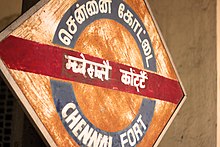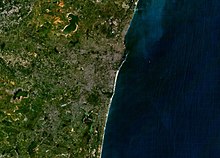Chennai
![]()
Madras is a redirect to this article. For other meanings, see Madras (disambiguation).
d1
Chennai (Tamil: சென்னை Ceṉṉai [ˈtʃenːɛi]), until 1996 Madras (Tamil: மெட்ராஸ் Meṭrās [ˈmeɖraːs] or மதராஸ் Matarās [ˈmad̪əraːs]), is the capital of the Indian state of Tamil Nadu. It is located on the east coast of southern India on the Bay of Bengal. According to the 2011 census, Chennai is the sixth most populous city in India, with a population of 4.6 million. An urban expansion in 2011 has since increased the population to an estimated 6.5 million. The agglomeration is home to 8.7 million people. This makes Chennai the center of the fourth largest metropolitan area in India.
Chennai emerged during the British colonial period around Fort St. George, founded in 1640. Under the name Madras, the city was an important centre of the British Empire in India. The official name was changed to Chennai in 1996.
The name of the city
Since 1996 the name of the city is officially Chennai, but the old name Madras is still common. Both names have been in parallel use since the 17th century. Chennai is short for Chennappattinam (pattinam meaning city) and was apparently the name of the settlement formed around Fort St. George, founded by the British in 1639. The name is usually derived from a local ruler named Chennappa Nayak. Madras or Madrasapattinam, on the other hand, seems to have originally been the name of a nearby village. The origin of the name is unclear: suggested derivations have been from the Arabic word madrasa for "school" (literally "place of study"), the Portuguese Madre de Deus ("Mother of God", after a church of the same name), a Portuguese merchant clan called Madeiros, and even the Sanskrit word Mandarajya ("realm of the simple-minded").
After the two places had grown together, Madras became the name of the city in English, while Chennai remained in use in Tamil. In 1996, the DMK-led government of Tamil Nadu arranged for the official name of the city to be changed from Madras to Chennai. By erasing the name Madras, which was closely associated with British colonial history and perceived as "un-Tamil", it was possible both to serve an anti-colonial sentiment and to emphasise the city's Tamil identity. Similarly, a number of other Indian cities have had their colonial-era names replaced (cf. the renaming of Bombay to Mumbai and Calcutta to Kolkata).

Trilingual sign (Tamil, Hindi, English) at Chennai Fort railway station. In Hindi, Madras was titled Chennai.
Geography
Location and extent
Chennai is located in southeastern India on the Coromandel Coast on the Bay of Bengal. Within the state of Tamil Nadu, the capital Chennai is located far to the northeast. It is only about 40 kilometers to the border of the northern neighboring state of Andhra Pradesh, while Cape Comorin, the southernmost point of Tamil Nadu and all of India, is 625 kilometers away.
As of 2011, the Chennai city has an area of 426 square kilometers. Before the expansion, Chennai's administrative urban area covered only 174 square kilometers, while the agglomeration had grown far beyond its boundaries. Coexisting with the city of Chennai is Chennai District, one of 32 districts of Tamil Nadu. Besides the city proper, the Chennai Metropolitan Area includes the wider catchment area of Chennai in the neighbouring districts of Tiruvallur and Kanchipuram. It has an area of 1189 square kilometers.
Chennai is located in the flat coastal plain with an average elevation of only six meters above sea level. On the seaside of Chennai is the 13-kilometer-long sandy Marina Beach. The Cooum and Adyar rivers flow through the city. The Cooum flows into the sea in the northern part and the Adyar in the southern part of Chennai. Five kilometers inland, the Buckingham Canal runs parallel to the coast, connecting the two rivers. To the southwest of Chennai, a few isolated hills rise from the otherwise flat surroundings. The most famous of these is St. Thomas Mount. Northwest of the city are several lakes of varying sizes.
City breakdown
Since the city expansion of 2011, Chennai is divided into 200 wards. Each ward is represented by a councillor in the Chennai Municipal Government. The 200 wards are grouped into the following 15 zones:
- I Tiruvottiyur
- II Manali
- III Madhavaram
- IV Tondiarpet
- V Royapuram
- VI Tiru Vi. Ka. Nagar
- VII Ambattur
- VIII Annanagar
- IX Teynampet
- X Kodambakkam
- XI Valasaravakkam
- XII Alandur
- XIII Adyar
- XIV Perungudi
- XV Sholinganallur
Climate
Chennai has an alternating humid tropical climate. The climate is hot and humid all year round and is only made more bearable by occasional sea breezes. The average annual temperature is 28.6 °C. The temperatures are subject to only slight fluctuations throughout the year: The warmest month is May with an average temperature of 33.0 °C, the coolest is January with 24.3 °C. Rainfall in Chennai, as in all of India, is significantly influenced by the monsoon. Unlike most of the country, the main rainy season on the southeast coast is the winter or northeast monsoon, which brings heavy rainfall from October to December. More than half of the annual rainfall of 1,197 millimeters falls during these three months. Rain also falls during the summer monsoon from July to September, but the rainfall is less. During the dry season between January and June there is hardly any rain.
| Chennai | ||||||||||||||||||||||||||||||||||||||||||||||||
| Climate diagram | ||||||||||||||||||||||||||||||||||||||||||||||||
| ||||||||||||||||||||||||||||||||||||||||||||||||
| Monthly average temperatures and precipitation for Chennai
Source: WMO | ||||||||||||||||||||||||||||||||||||||||||||||||||||||||||||||||||||||||||||||||||||||||||||||||||||||||||||||||||||||||||||||||||||||||||||||||||||||||||||||||||||||||||||||||||||||||||||||||

Map of the zones and districts of Chennai

Satellite image of Chennai and surroundings
Questions and Answers
Q: What is the former name of Chennai?
A: The former name of Chennai was Madras.
Q: How many people live in Chennai?
A: Approximately 7 million people live in Chennai.
Q: What is the fourth largest city of India?
A: The fourth largest city of India is Chennai.
Q: When was Chennai founded?
A: Chennai was founded in 1661 by the British East India Company.
Q: What is the longest beach located in Chennai?
A: The longest beach located in Chennai is Marina Beach, which is 12 km (7 mi) long.
Q: Which two rivers divide the city into three parts?
A: The Cooum River and Adyar River divide the city into three parts.
Q: What runs through the city almost parallel to its coast?
A: The Buckingham Canal runs through the city almost parallel to its coast.
Search within the encyclopedia